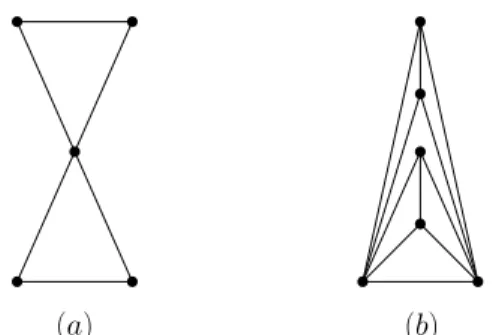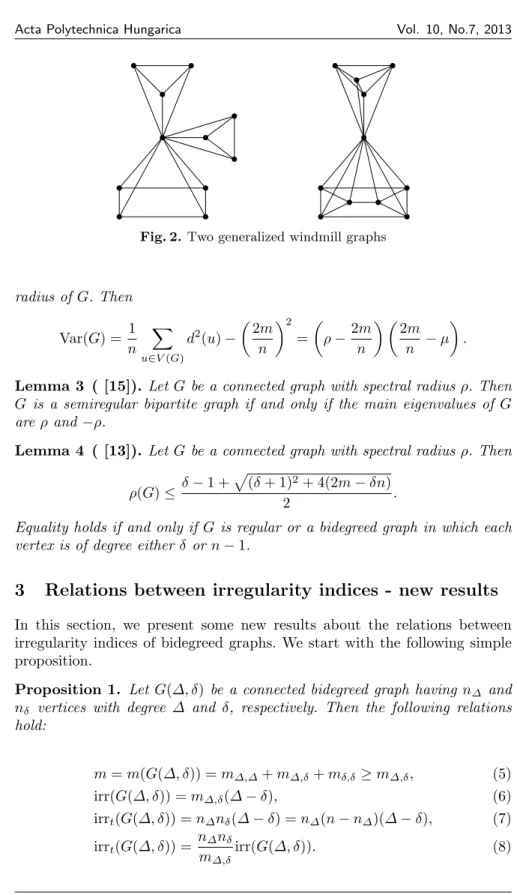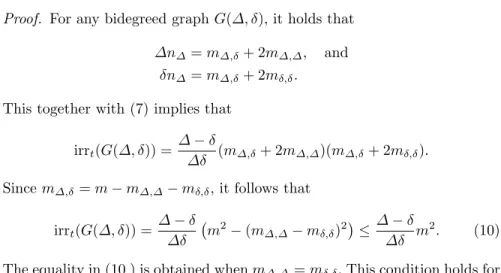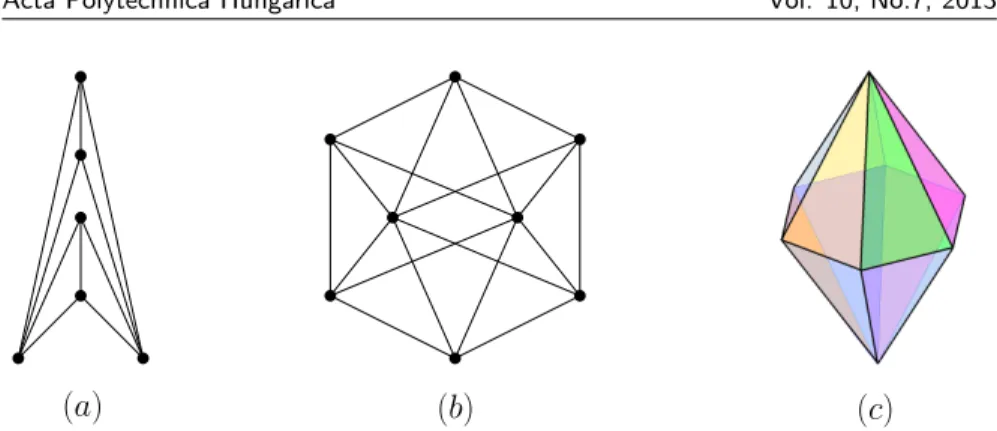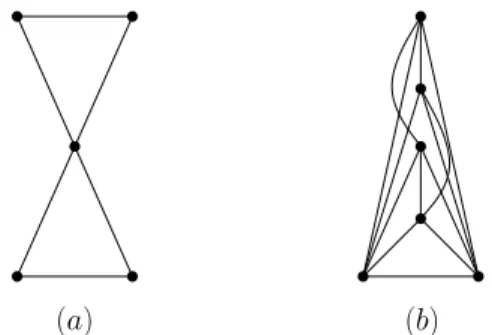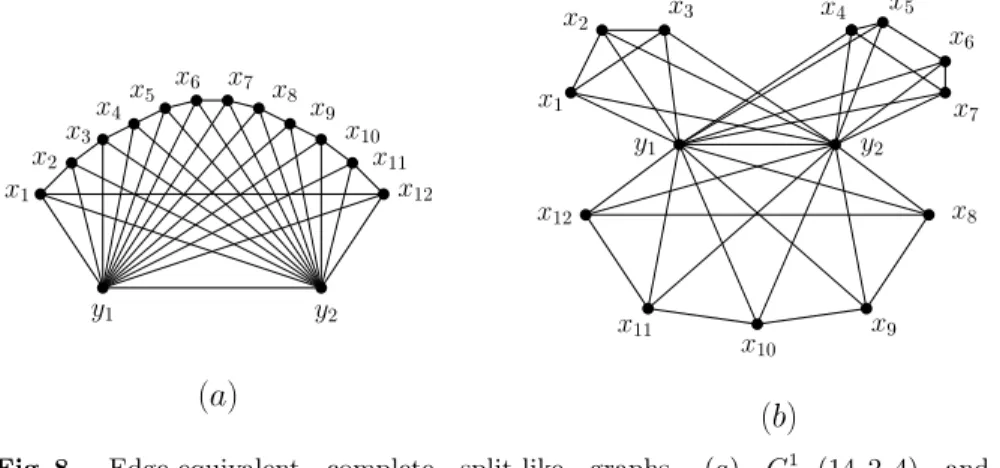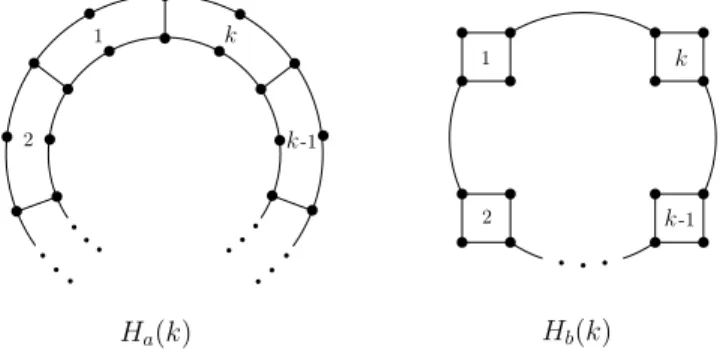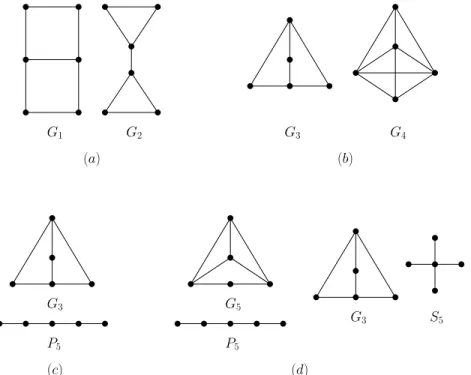On Irregularities of Bidegreed Graphs
Tam´ as R´ eti
1, Darko Dimitrov
21Obuda University´
B´ecsi ´ut 96/B, H-1034 Budapest, Hungary E-mail:reti.tamas@bgk.uni-obuda.hu
2Institut f¨ur Informatik, Freie Universit¨at Berlin Takustraße 9, D–14195 Berlin, Germany
& Hochschule f¨ur Technik und Wirtschaft Berlin Wilhelminenhofstraße 75A, D–12459 Berlin, Germany E-mail:dimdar@zedat.fu-berlin.de
Abstract: A graph is regular if all its vertices have the same degree. Otherwise a graph isirregular. To measure how irregular a graph is, several graph topological indices were proposed including: theCollatz-Sinogowitz index [8], thevariance of the vertex degrees [7], the irregularity of a graph [4], and recently proposed the total irregularity of a graph [1]. Here, we compare the above mentioned irregularity measures for bidegreed graphs.
Keywords:topological graph indices; complete split graph; 2-walk linear graph
1 Introduction
All graphs considered here are simple and undirected. Let Gbe a graph of ordern=|V(G)|and sizem=|E(G)|. Forv∈V(G), the degree ofv, denoted bydG(v), is the number of edges incident tov. Theadjacency matrix A(G) of a graph Gis a matrix with rows and columns labeled by graph vertices, with a 1 or a 0 in position (vi, vj) according to whether vertices vi and vj
are adjacent or not. The characteristic polynomialφ(G, t) of G is defined as characteristic polynomial of A(G): φ(G, λ) = det(λIn−A(G)), where In is n×nidentity matrix. The set of eigenvalues of the adjacent matrixA(G) of a graphGis called agraph spectrum. The largest eigenvalue ofA(G), denoted by ρ(G), is called the spectral radius of G. An eigenvalue of a graph G is called main eigenvalue if it has an eigenvector the sum of whose entries is not equal to zero.
In the sequel, we present the irregularity measures consider in this paper.
Collatz-Sinogowitz [8] introduced the irregularity measure of a graphGas CS(G) =ρ(G)−2m
n . (1)
An alternative to CS(G) is thevariance of the vertex degrees Var(G) = 1
n
n
X
i=1
d2G(vi)− 1 n2
n
X
i=1
dG(vi)
!2
. (2)
Bell [7] was first who has compared CS(G) and Var(G) and showed that they are not always compatible. Albertson [4] defines the imbalance of an edge e=uv∈E as|dG(u)−dG(v)|and theirregularityofGas
irr(G) = X
uv∈E
|dG(u)−dG(v)|. (3) Recently, in [1] a new measure of irregularity of a simple, undirected graph, so-called the total irregularity, was defined as
irrt(G) = 1 2
X
u,v∈V(G)
|dG(u)−dG(v)|. (4) More about the above presented irregularity measures, comparison studies of them, and other attempts to measure the irregularity of a graph, one can find in [3, 6, 10–12]. It is interesting that the above four irregularity measures are not always compatible for some pairs of graphs. In this paper we study the relations between the above mentioned irregularity measures for bidegreed graphs.
Auniversalvertex is the vertex adjacent to all other vertices. A set of vertices is said to be independent when the vertices are pairwise non-adjacent. The vertices from an independent set areindependent vertices.
Thedegree set, denoted byD(G), of a simple graphGis the set consisting of the distinct degrees of vertices inG.
The distance between two vertices in a graph is the number of edges in a shortest path connecting them. Theeccentricityof a vertexvin a connected graph G is the maximum graph distance between v and any other vertex of G. The radius of a graph G, denoted by rad(G), is the minimum graph eccentricity of any graph vertex of G. Thediameter of a graph G, denoted by diam(G), is the maximal graph eccentricity of any graph vertex ofG.
Let mr,s denotes the number of edges in G with end-vertex degrees r and s, and let nr denotes the numbers of vertices n Gwith degree r. Numbers mr,s andnrare referred as theedge-parametersand thevertex-parametersof G, respectively . Themean degreeof a graphGis defined asd(G) = 2m/n.
GraphsG1 andG2 are said to beedge-equivalent if for their corresponding edge-parameters sets{mr,s(G1)>0}={mr,s(G2)>0}holds. Analogously, they are calledvertex-equivalentif for their vertex-parameters sets{nr(G1)>
0}={nr(G2)>0}is fulfilled. It is easy to see that if two graphs are edge- equivalent, then they are vertex-equivalent, as well.
For two graphs G1 andG2 with disjoint vertex setsV(G1) and V(G2) and disjoint edge setsE(G1) and E(G2) thedisjoint union of G1 andG2 is the graph G = G1∪G2 with the vertex set V(G1)∪V(G2) and the edge set E(G1)∪E(G2). The join G+H of simple undirected graphs G and H is the graph with the vertex set V(G+H) =V(G)∪V(H) and the edge set E(G+H) =E(G)∪E(H)∪ {uv:u∈V(G), v∈V(H)}. Let Cn denote a cycle onnvertices. Further, letKn denote the complete graph onnvertices, andtK1 denote the graph witht isolated vertices and no edges.
A graphGis acompletek-partitegraph if there is a partitonV1∪ · · · ∪Vk= V(G) of the vertex set, such that uv ∈ E(G) if and only if u and v are in different parts of the partition. A connected bipartite graphGissemiregularif every edge ofGjoins a vertex of degreeδto a vertex of degree∆. A connected graphs Gis called abalanced irregular graph if the equality irr(G) = irrt(G) holds.
The rest of the paper is structured as follows. In Section 2 we present some types of bidegreed graphs and some known results related to the above men- tioned irregularity measures. In Section 3 we investigate new relations be- tween irregularity indices of bidegreed graphs. Bidegreed graphs with same irregularity indices are investigated in Section 4. We conclude with final re- marks and open problems in Section 5.
2 Some types of bidegreed graphs and known results
A graphGis calledbidegreedif its degree setD(G) ={∆, δ}with∆ > δ≥1.
In the sequel, we present some special types of connected bidegreed graphs that will be of interest later.
i) A bidegreed graph is called a balanced bidegreed graph if the equality n∆nδ = m∆,δ holds for it. It should be noted that the complete bipartite graphs, for which m=m∆,δ =n∆nδ =∆δ holds, form a subset of balanced bidegreed graphs.
ii) A balanced bidegreed graph withnvertices is called acomplete split graph if it containsq=n∆≥1 universal vertices andn−qindependent vertices [5].
Thus, a complete split graph, denoted byGcs(n, q), can be obtained as join ofn−qgraphsK1 and the complete graphKq, i.e.,Gcs(n, q) = (n−q)K1+ Kq. An existing complete split graph Gcs(n, q) is uniquely defined by their parametersnandq. This implies that two complete split graphs with identical n, q parameters are isomorphic. For a complete split graph the equalities m=m∆,δ+m∆,∆and 2m= (2n−1)δ−δ2 hold [5].
iii) A balanced bidegreed graph is called acomplete split-like graph, denoted by Gcsl(n, q, δ), if it has q ≥ 1 universal vertices. This implies that for a complete split-like graph the equalityqnδ =m∆,δ holds. The complete split
graphs represent a subset of complete split-like graphs. It is easy to see that if G is a complete split-like graph then the equalities rad(G) = 1 and diam(G) = 2 are fulfilled. In Fig. 1 non-isomorphic complete split-like graphs with 5 and 6 vertices are depicted. Note that they are not complete split graphs.
(a) (b)
Fig. 1.Complete split-like graphs (a)Gcsl(5,1,2) and (b)Gcsl(6,2,3)
Also note that since for a complete split-like graphG qnδ =m∆,δ, it follows that if G is not a complete bipartite graph, then G is non-bipartite and contains a triangle.
iv) In a particular case, if q = 1, then a complete split-like graph is called a generalized windmill graphand is denoted by Gcsl(n,1, δ). We would like to recall that the classical windmill graph, denoted byWd(k, p), can be con- structed by joiningpcopies of the complete graphKk with a common vertex.
For a generalized windmill graph the equalitym=m∆,δ+mδ,δ is fulfilled. It follows that the star graphsSnwithn≥3 vertices, the wheel graphsWnwith n≥5 vertices, and the classical windmill graphsWd(k, p) with (k−1)p+ 1 vertices andpk(k−1)/2 edges defined fork≥2 andp≥2 positive integers, form the subsets of generalized windmill graphs. In Fig. 2 two non-isomorphic generalized windmill graphs are depicted.
Next, we state some known results that will be used afterwords.
Lemma 1 ( [16]).LetGbe a connected bidegreed graph with spectral radius ρ(G). Then
ρ(G) = v u u t 1 n
X
u∈V(G)
d2(u) =√
∆δ,
if and only if G is a semiregular connected bipartite graph.
Lemma 2 ( [15]). Let G be a connected graph with mean degree d(G)] = 2m/n, and just two main eigenvalues, ρ andµ < ρ, where ρ is the spectral
Fig. 2.Two generalized windmill graphs
radius of G. Then Var(G) = 1
n X
u∈V(G)
d2(u)− 2m
n 2
=
ρ−2m n
2m n −µ
.
Lemma 3 ( [15]).Let Gbe a connected graph with spectral radiusρ. Then G is a semiregular bipartite graph if and only if the main eigenvalues of G are ρand−ρ.
Lemma 4 ( [13]).Let Gbe a connected graph with spectral radiusρ. Then
ρ(G)≤δ−1 +p
(δ+ 1)2+ 4(2m−δn)
2 .
Equality holds if and only if Gis regular or a bidegreed graph in which each vertex is of degree eitherδ orn−1.
3 Relations between irregularity indices - new results
In this section, we present some new results about the relations between irregularity indices of bidegreed graphs. We start with the following simple proposition.
Proposition 1. Let G(∆, δ) be a connected bidegreed graph havingn∆ and nδ vertices with degree ∆ and δ, respectively. Then the following relations hold:
m=m(G(∆, δ)) =m∆,∆+m∆,δ+mδ,δ≥m∆,δ, (5)
irr(G(∆, δ)) =m∆,δ(∆−δ), (6)
irrt(G(∆, δ)) =n∆nδ(∆−δ) =n∆(n−n∆)(∆−δ), (7) irrt(G(∆, δ)) = n∆nδ
m∆,δ
irr(G(∆, δ)). (8)
Proof. It is obvious that for a connected bidegreed graphG(∆, δ) the equality m=m∆,δ holds if and only if G(∆, δ) is semiregular. The equalities (6), (7) and (8) follow from the definitions of irregularity indices.
Because the function f(n∆) =n−n∆ has a maximum value forn∆=n/2, we have the following corollary.
Corollary 1. For a connected bidegreed graphG(∆, δ)it holds that
irrt(G(∆, δ)) =n∆(n−n∆)(∆−δ)≤n2
4 (∆−δ). (9)
Inequality (9) is sharp. There exist bidegreed graphs withnvertices for which irrt(G(∆, δ)) =n2(∆−δ)/4.Such bidegreed graphs with 8 vertex and deegre set {3,4}are shown in Fig. 3(a). These graphs are non edge-equivalent, but only vertex equivalent, and the equality n3=n4 =n/2 = 4 holds for them.
Another example of bidegreed graphs that satisfy equality in (9) is given in Fig. 3(b). Those graphs are with 8 vertices and have deegre set {2,3}.
They are edge-equivalent, and satisfy the equalityn2 =n3 =n/2 = 4. It is interesting to note that the graphs in Fig. 3(b) are not only edge-equivalent (m2,3= 8, m3,3= 2), but they have identical spectral radius (1 +√
17)/2, as well. Consequently, all considered irregularity indices (CS, Var, irr and irrt ) are identical for them.
(a) (b)
Fig. 3.Examples of non-isomorphic bidegreed graphs with 8 vertices with identical maximum total irregularity indices
Proposition 2. Let G(∆, δ)be a connected bidegreed graph, then
irrt(G(∆, δ)) = ∆−δ
∆δ m2−(m∆,∆−mδ,δ)2
≤∆−δ
∆δ m2. The equality holds ifm∆,∆=mδ,δ.
Proof. For any bidegreed graphG(∆, δ), it holds that
∆n∆=m∆,δ+ 2m∆,∆, and δn∆=m∆,δ+ 2mδ,δ.
This together with (7) implies that irrt(G(∆, δ)) = ∆−δ
∆δ (m∆,δ+ 2m∆,∆)(m∆,δ+ 2mδ,δ).
Sincem∆,δ =m−m∆,∆−mδ,δ, it follows that irrt(G(∆, δ)) = ∆−δ
∆δ m2−(m∆,∆−mδ,δ)2
≤ ∆−δ
∆δ m2. (10) The equality in (10 ) is obtained whenm∆,∆=mδ,δ. This condition holds for the bidegreed graphs with 10 vertices and 12 edges in Fig. 4. Consequently all of them have the same maximum total irregularity index irrt =n2n3 = 6·4 = 24.
Ja Jb Jc Jd
Fig. 4. Bidegreed graphs having identical vertex degree set (n3 = 4, n2 = 6) and identical maximum total irregularity index irrt= 24
Among bidegreed graphs having identical vertex degree set (n∆, nδ), the semiregular graphs (for which the equality m∆,∆ = mδ,δ=0 holds) possess the maximal irregularity irr(G), as it is a case with graphs Jc and Jd in Fig. 4.
4 Bidegreed graphs with same irregularity indices
In the following we will show that there exists a broad class of bidegreed graphs having “similar irregularity”, or in other words, there exist non- isomorphic graph pairs for which two (or more than two) irregularity indices are equal. Moreover, we will show that there are some particular classes of bidegreed graphs whose irregularity indices are considered algebraically de- pendent quantities.
4.1 Balanced bidegreed graphs
From the definition of balanced bidegreed graphs, it follows that irr(G(∆, δ)) = irrt(G(∆, δ)) =n∆nδ(∆−δ) =m∆,δ(∆−δ).
This implies that the balanced bidegreed graphs form a subset of balanced irregular graphs.
Proposition 3. LetG(∆, δ)be a balanced bidegreed graph for whichm∆,∆= 0 ormδ,δ = 0hold. Then
irr(G(∆, δ)) = irrt(G(∆, δ)) = (2m−∆δ)(∆−δ).
Proof. For any bidegreed graphG(∆, δ)
∆n∆=m∆,δ+ 2m∆,∆, δnδ =m∆,δ+ 2mδ,δ. Consequently, we get
n∆nδ =m∆,δ =(m∆,δ+ 2m∆,∆)(m∆,δ+ 2mδ,δ)
∆δ , and
m2∆,δ+ (2(m∆,∆+mδ,δ)−∆δ)m∆,δ+ 4m∆,∆mδ,δ = 0.
Taking into consideration thatm∆,∆+mδ,δ=m−m∆,δ, we have m2∆,δ+ (∆δ−2m)m∆,δ−4m∆,∆mδ,δ= 0.
Becausem∆,δ is a positive number it is easy to see that the proper solution of the equation above is
n∆nδ=m∆,δ= 1 2
2m−∆δ+q
(2m−∆δ)2+ 16m∆,∆mδ,δ
.
If as a particular case the equality m∆,∆mδ,δ = 0 holds for graph G(∆, δ), one obtains
n∆nδ =m∆,δ= 2m−∆δ, from which the main result follows.
Example 1.We present two infinite sequences of balanced bidegreed graphs with the property m∆,∆mδ,δ = 0. The first infinite sequence is comprised of graphs B(k), where k is a positive integer. The case k = 2 is depicted in Fig. 5(a). A graph B(k) has a vertex degree distribution n3 = 2k and n2k = 2, and edge number m = 5k, wherek ≥2 positive integer. It is easy to see that for graphsB(k), the equalitym2k,2k= 0 holds.
(a) (b) (c)
Fig. 5.Balanced planar bidegreed graphs. (a) Planar graphB(2) and (b),(c) Poly- hedral graphP(6) of 6-gonal bipyramid
The second infinite sequence is comprised ofk-gonal bipyramids. A k-gonal bipyramid, with integer k ≥3, is formed by joining ak-gonal pyramid and its mirror image base-to-base. It is a polyhedon having 2k triangular faces.
The case k= 6 is depicted in Fig. 5(b) and redrawn in Fig. 5(c) for a better illustration. The graph P(k) of a k-gonal bipiramid belongs to the family of balanced bidegreed graphs with degree 4 and k. For these graphs the equalitiesn4nk=m4k = 2k, m= 3k andmk,k= 0 hold.
4.2 Complete split graphs and complete split-like graphs
Proposition 4 ( [2]).There exist a complete split graph pairs withnvertices Gcs(n, q)andGcs(n, q+1)with certainnandqpositive integers, for which the equality irrt(Gcs(n, q)) = irrt(Gcs(n, q+ 1)) = irr(Gcs(n, q)) = irr(Gcs(n, q+ 1)) holds.
Example 2. The smallest complete split graph pair with this property is the star graph on 5 verticesGcs(5,1), and the graphGcs(5,2) are depicted in Fig. 6.
For graphsGcs(5,1) andGcs(5,2) the following equality holds: irrt(Gcs(5,1)) = irrt(Gcs(5,2)) = irr(Gcs(5,1)) = irr(Gcs(5,2)) = 12.
Proposition 5. Let Gcsl(n, q, δ) be a complete split-like graph. Then irr(Gcsl(n, q, δ)) = irrt(Gcsl(n, q, δ)) =q(n−q)(n−1−δ).
Proof. Since the complete split-like graphs form a subset of balanced bide- greed graphs, it is easy to see that
irr(Gcsl(n, q, δ)) =m∆,δ|∆−δ|=n∆nδ|∆−δ|=q(n−q)(n−1−δ)
= irrt(Gcsl(n, q, δ)).
(a) (b)
Fig. 6. Complete split graphs (a)Gcs(5,1) and (b)Gcs(5,2) with different degree sets
Proposition 6. There exist complete split-like graph pairs Gcsl(na, qa, δa) andGcsl(nb, qb, δb)with differentna, nb, qa, qb, δaandδbparameters, for which the equality
irrt(Gcsl(na, qa, δa)) = irrt(Gcsl(nb, qb, δb)) = irr(Gcs(na, qa, δa))
= irr(Gcs(nb, qb, δb)) holds.
Proof. A complete split-like graph pair with this property is the graph pair Gcsl(5,1,2) and Gcsl(6,2,4) depicted in Fig. 7. For these graphs, equality irrt(Gcsl(5,1,2)) = irrt(Gcsl(6,2,4)) = irr(Gcs(5,1,2)) = irr(Gcs(6,2,4)) = 8 holds.
(a) (b)
Fig. 7. Complete split-like graphs (a) Gcsl(5,1,2) and (b)Gcsl(6,2,4) with equal irr and irrt measures
There are several ways to construct complete split-like graphs. For example, a complete split-like graph withnverticesGcsl(n, q, δ) can be generated using the following graph operations:
Gcsl(n, q, δ) =Kq+ ∪Jj=1H(j, R) .
In the formula above, Kq is the complete graph on q≥ 1 vertices,H(j, R) areR≥1 regular connected graphs for j= 1,2, . . . , J.
As an example, in Fig. 8 two non-isomorphic edge-equivalent complete split- like graphs are shown. These complete split-like graphs are defined as G1csl(14,2,4) = K2+C12 and G2csl(14,2,4) = K2 + (C3 ∪C4 ∪C5), re- spectively. It is easy to see that irrt(G1csl(14,2,4)) = irrt(G2csl(14,2,4)) =
(a) (b)
y1 y2
x1
x2 x3 x4 x5
x6
x7
x8
x9
x10 x11
x12
y1 y2
x1
x2
x3
x4x5 x6 x7 x8 x9
x10
x11
x12
Fig. 8. Edge-equivalent complete split-like graphs, (a) G1csl(14,2,4) and (b)G2csl(14,2,4)
irr(G1csl(14,2,4)) = irr(G2csl(14,2,4)) = 216.
From the previous considerations the following result follows.
Proposition 7. LetG1andG2be edge-equivalent complete split-like graphs.
Then the equalities irrt(G1) = irrt(G2) = irr(G1) = irr(G2), Var(G1) = Var(G2)andCS(G1) = CS(G2)are fulfilled for them.
Proof. BecauseG1 andG2 are edge-equivalent graphs, this implies that the equalities irrt(G1) = irrt(G2),irr(G1) = irr(G2) and Var(G1) = Var(G2) hold. Moreover, becauseG1 andG2 are complete split-like graphs, in which each vertex is of degreeδorn−1, it follows from Lemma 4 that their spectral radii are identical.
For an illustration of Proposition 7, see the complete split-like graph pair depicted in Fig. 8.
4.3 Semiregular graphs
It is important to note that except the complete bidegreed bipartite graphs, the semiregular graphs do not belong to the family of balanced bidegreed graphs.
Proposition 8. LetS1(∆1, δ1)andS2(∆2, δ2)be semiregular graphs for which
∆=∆1=∆2, δ=δ1=δ2, andm∆,δ=m(S1) =m(S2)hold. Then, CS(S1) = CS(S2) =√
∆δ− 2∆δ
∆+δ, and
Var(Si) = √
∆δ+ 2∆δ
∆+δ
CS(Si),
for i = 1,2, where CS(G) is the Collatz-Sinogowitz irregularity index of a graph G.
Proof. It is easy to see that for a semiregular graphS withnvertices n=n∆+nδ = m∆,δ
∆ +m∆,δ
δ =∆+δ
∆δ m∆,δ. This implies that for the mean degreesdwe have
d(S1) =d(S2) = 2m∆,δ
n = 2∆δ
∆+δ. From Lemma 1 one obtains
ρ=ρ(S1) =ρ(S2) =√
∆δ.
consequently, we have
CS(S1) = CS(S2) =ρ−2m∆,δ
n =√
∆δ− 2∆δ
∆+δ.
Moreover, from Lemmas 2 and 3, it follows that for a semiregular graphs S Var(S) =
ρ−2m
n
2m n +ρ
=ρ2− 2m
n 2
=∆δ− 2∆δ
∆+δ 2
= √
∆δ+ 2∆δ
∆+δ
CS(S).
This implies that
Var(Si) = √
∆δ+ 2∆δ
∆+δ
CS(Si).
fori= 1,2.
Proposition 9. LetS1(∆1, δ1)andS2(∆2, δ2)be semiregular graphs for which
∆ =∆1 =∆2, δ = δ1 = δ2, and m∆,δ =m(S1) = m(S2) hold. Then, the equalitiesirrt(S1) = irrt(S2),irr(S1) = irr(S2)are fulfilled for them.
Proof. It is obvious that
irr(S1) = irr(S2) =m∆,δ(∆−δ).
Moreover, because for a semiregular graph n∆nδ= m2∆,δ
∆δ , we get
irrt(S1) = irrt(S2) =n∆nδ(∆−δ) =∆−δ
∆δ m2∆,δ.
As a consequence of Proposition 8 and 9, we have the following result.
Corollary 2. Let S1(∆1, δ1)andS2(∆2, δ2)be semiregular graphs for which
∆ = ∆1 = ∆2, δ = δ1 = δ2, and m∆,δ = m(S1) = m(S2) hold. Then the equalities irrt(S1) = irrt(S2),irr(S1) = irr(S2),Var(S1) = Var(S2) and CS(S1) = CS(S2) are fulfilled for them.
GraphsJcandJd depicted in Fig. 4 satisfy Corollary 2. From Proposition 9, we have the following corollary.
Corollary 3. Let S(∆, δ) be a semiregular graph. Then,
irrt(S(∆, δ)) = irr2(S(∆, δ))
∆δ(∆−δ) .
4.4 Bidegreed graphs with identical CS,Var,irr and irrt indices In Fig. 3(b), Proposition 7 and Corollary 2 examples of pairs of bidegreed graphs were presented, with the property that both graphs from a given pair have identical CS,Var,irr and irrt. Next, we present another such pair of graphs. A 6-vertex graph pair with degree set {2,3} and with identical CS,Var,irr and irrt indices is depicted in Fig. 9. These graphs are edge- equivalent (m2,3 = 4, m3,3 = 4), and they have identical spectral radius 1 +√
3.
In the sequel, we show that there exists an infinitely large family of pairs of bidegreed graphs with identical CS,Var,irr and irrtindices . For that purpose, first we need the following definition:
Letd2(v) denote the sum of the degrees of all vertices adjacent to a vertexv in a graphG. Then,Gis called 2-walk linear (more precisely, 2-walk (a, b)- linear)) if there exists a unique rational numbers pair (a, b) such that
d2(v) =a·d(v) +b holds for every vertexv ofG.
Fig. 9. Tricyclic, bidegreed, edge equivalent graph pair with identical spectral ra- dius 1 +√
3 [9]
Lemma 5 ( [14]). A graphGhas exactly two main eigenvalues if and only ifGis2-walk linear. Moreover, ifGis a 2-walk(a, b)-linear connected graph, then parameters aandb must be integers, and the spectral radius ofG is
ρ= 1 2
a+p
a2+ 4b .
Using the above lemma we will demonstrate by examples that there are infinitely many bidegreed graph pairs having identical irregularity indices CS,Var,irr and irrt.
Example 3.Consider the two infinite sequences of bidegreed graphs denoted by Ga(k) andGb(k) (an illustration when k = 5 is given in Fig. 10). Both Ga(k) andGb(k) are of order 3k, where k≥3. GraphsGa(k) andGb(k) are
Ga(k) Gb(k)
k= 5 k= 5
Fig. 10.Bidegreed graph pairGa(5) andGb(5)
edge-equivalent, because the identitiesm2,2=k, m2,4= 2k, m4,4=k, m= 4k are fulfilled. Moreover,Ga(k) and Gb(k) are 2-walk (3,0) linear graphs. By Lemma 5, it follows that they have identical spectral radius which is equal to 3. It is easy to show that for graphsGa(k) andGb(k) the following equal- ities hold: CS(Ga(k)) = CS(Gb(k)) = 1/3, Var(Ga(k)) = Var(Gb(k)) = 8/9,
irr(Ga(k)) = irr(Gb(k)) = 4k, and irrt(Ga(k)) = irrt(Gb(k)) = 8k2. It is in- teresting to note that irr(Ga(k))/n= irr(Gb(k))/n= 4/3, and irrt(Ga(k))/n2
= irrt(Gb(k))/n2= 4/9, for anyk≥3.
Example 4. Another infinite sequence of bidegreed graph pairs denoted by Ha(k) andHb(k) is shown in Fig. 11. Each of them hasn= 4kvertices, where k ≥2. GraphsHa(k) andHb(k) are edge-equivalent, because the identities
Ha(k) k 1
2 k-1
1 k
2
Hb(k) k-1
Fig. 11.Bidegreed graph pairHa(k) andHb(k)
m2,3 = 4k = n, m3,3 = k, and m = 5k hold. It is easy to see that Ha(k) andHb(k) are 2-walk (1,4) linear graphs. From this it follows that they have identical spectral radius which is equal to 1 +√
17
/2. For graphsHa(k) and Hb(k) the following equalities hold: CS(Ha(k)) = CS(Hb(k)) = (√
17−4)/2, Var(Ha(k)) = Var(Hb(k)) = 1/4, irr(Ha(k))/n = irr(Hb(k))/n = 1, and irrt(Ha(k))/n2= irrt(Hb(k))/n2= 1/4).
Example 5.Semi-regular bidegreed graph pairs denoted byJa(k) andJb(k) are shown in Fig. 12. Both of them are comprised ofn= 5k vertices, where k≥2. GraphsJa(k) andJb(k) are edge-equivalent, since the identitym2,3= 6kis fulfilled. Moreover, these graphs are 2-walk (0,6) linear. Consequently, they have identical spectral radius which is equal to √
6. For graphs Ja(k) andJb(k) the following equalities hold: CS(Ja(k)) = CS(Jb(k)) =√
6−12/5, Var(Ja(k)) = Var(Jb(k)) = 6/25, irr(Ja(k))/n = irr(Jb(k))/n = 6/5, and irrt(Ja(k))/n2= irrt(Jb(k))/n2= 6/25.
4.5 Smallest bidegreed graphs with identical irregularity indices In this section we present pairs of smallest graphs that have identical two or more irregularity measures. The results were obtained by computer search.
For two graphs of same orderG1= (V1, E1) andG2= (V2, E2), we said that G1 is smaller than G2 if|E1| <|E2|. Consequently, for two pairs of graphs of same orderD1= (G1, G2) andD2= (G3, G4), we said thatD1 is smaller thanD2if|E1|+|E2|<|E3|+|E4|.
Ja(k) k 1
2 k-1
1 k
2
Jb(k) k-1
Fig. 12. Bidegreed graph pairJa(k) andJb(k)
First, in Fig. 13(a) the smallest pair of graphs, that have identical all four irregularity indices CS,Var,irr and irrt, is presented. The graphsG1andG2
are of order 6 and size 7. Their CS,Var,irr and irrt indices are 0.080880, 0.266667, 4, and 8, respectively. They also have same spectral radius which is 2.414214. We note that the pair (G1, G2) is at same time the smallest pair of graphs with equal CS index.
G3
P5
G3 S5
G1 G2
(a) (b)
(c) (d)
G4 G3
P5 G5
Fig. 13.Smallest bidegreed graphs with identical irregularity indices
In Fig. 13(b) the smallest pair of graphs, that have identical Var,irr and irrt
indices is presented. This pair is also the smallest pair with the property that both graphs have equal Var and irr indices. The graphsG3 andG4 are of order 5 and sizes 6 and 9, respectively. Their Var,irr and irrt indices are 0.300000, 6, and 6, respectively.
The pair (P5, G3), depicted in Fig. 13(c), is the smallest pair with the property that both graphs have equal Var and irrt indices. At same time, it is the smallest pair with both graphs having equal Var index. Also, it is the smallest pair with both graphs having equal irrtindex. Their Var and irrtindices are 0.300000 and 6, respectively.
The pair (S5, G3), depicted in Fig. 13(d), is the smallest pair with the prop- erty that both graphs have equal irr and irrtindices. It holds that irr(S5) = irr(G3) = 12 and irrt(S5) =irr(G3) = 12. At same time, together with the pair (P5, G5), it is the smallest pair with both graphs having equal irr index.
5 Final remarks and open problems
In this paper we focused our investigation to the study of the relations be- tween the irregularity indices of bidegreed connected graphs. Comparing the irregularity indices of various graphs, in the majority of cases it was supposed that the number of vertices or the corresponding degree sets are identical (see Figures 3, 4, 6, 8, 9, 10, 11, 12, 13(a)). It would be interesting to consider graphs of same order which have different degree sets, but their corresponding irregularity indices are identical (as few examples in Fig. 13(b),(c),(d)).
Another interesting problem is to estimate the maximum possible difference of vertex and edge numbers of graphs having identical irregularity indices (assuming that such positive finite integer exists.) Both cases, when graphs are of same or different order, are of interest. In Fig. 14, bidegreed graphs B(6,5) andB(3,2) represent an example concerning this problem. We would
B(6,5) B(3,2)
Fig. 14.Bidegreed graphs with identical irrt= 24 and irr = 12 indices
like to note that, the bidegreed polyhedral graphB(6,5) is the dual of the
graph of the smallestC24fullerene which is composed of 12 pentagonal and 2 hexagonal faces, and graphB(3,2) is a semiregular graph. It is worth noting that graph B(6,5) has 14 vertices and 36 edges, while graphB(3,2) has 10 vertices and 12 edges. It is surprising that there is a large difference between the corresponding edge-numbers of the two graphs, (36−12 = 24).
References
1. H. Abdo, D. Dimitrov, The total irregularity of a graph, arxiv.org/abs/1207.
5267, 2012.
2. H. Abdo, N. Cohen, D. Dimitrov,Bounds and computation of irregularity of a graph, http://arxiv.org/abs/1207.4804, 2012.
3. Y. Alavi, J. Liu, J. Wang,Highly irregular digraphs, Discrete Math.111(1993) 3–10.
4. M. O. Albertson,The irregularity of a graph, Ars Comb.46(1997) 219–225.
5. M. Aouchiche, F. K. Bell, D. Cvetkovi´c, P. Hansen, P. Rowlinson, S. K. Simi´c, D. Stevanovi´c, Variable neighborhood search for extrenmal graphs. 16. Some conjectures related to the largest eivenvalue of a graph, Eur. J. Oper. Res.191 (2008) 661–676.
6. F. K. Bell, On the maximal index of connected graphs, Linear Algebra Appl.
144(1991) 135–151.
7. F. K. Bell, A note on the irregularity of graphs, Linear Algebra Appl. 161 (1992) 45–54.
8. L. Collatz, U. Sinogowitz,Spektren endlicher Graphen, Abh. Math. Sem. Univ.
Hamburg21(1957) 63–77.
9. X. Fan, Y. Luo, Tricyclic graphs with exactly two main eigenvalues, http://arxiv.org/abs/1012.0963, 2010.
10. I. Gutman, P. Hansen, H. M´elot, Variable neighborhood search for extremal graphs.10. Comparison of irregularity indices for chemical trees, J. Chem. Inf.
Model.45(2005) 222–230.
11. P. Hansen, H. M´elot, Variable neighborhood search for extremal graphs. 9.
Bounding the irregularity of a graph, in Graphs and Discovery, DIMACS Ser.
Discrete Math. Theoret. Comput. Sci69(2005) 253–264.
12. M. A. Henning, D. Rautenbach,On the irregularity of bipartite graphs, Discrete Math.307(2007) 1467–1472.
13. Y. Hong, J-L. Shu, K. Fang, A sharp upper bound of the spectral radius of graphs,J. Combin. Theory Ser. B81(2001) 177–183.
14. Y. Hou, F. Tian, Unicyclic graphs with exactly two main eigenvalues,Appl.
Math. Lett.19(2006) 1143–1147.
15. P. Rowlinson,The main eigenvalues of a graph: A survey,Appl. Anal. Discrete Math.1(2007) 445–471.
16. A. Yu, M. Lu, F. Tian,On the spectral radius of graphs,Linear Algebra Appl.
387(2004) 41–49.
